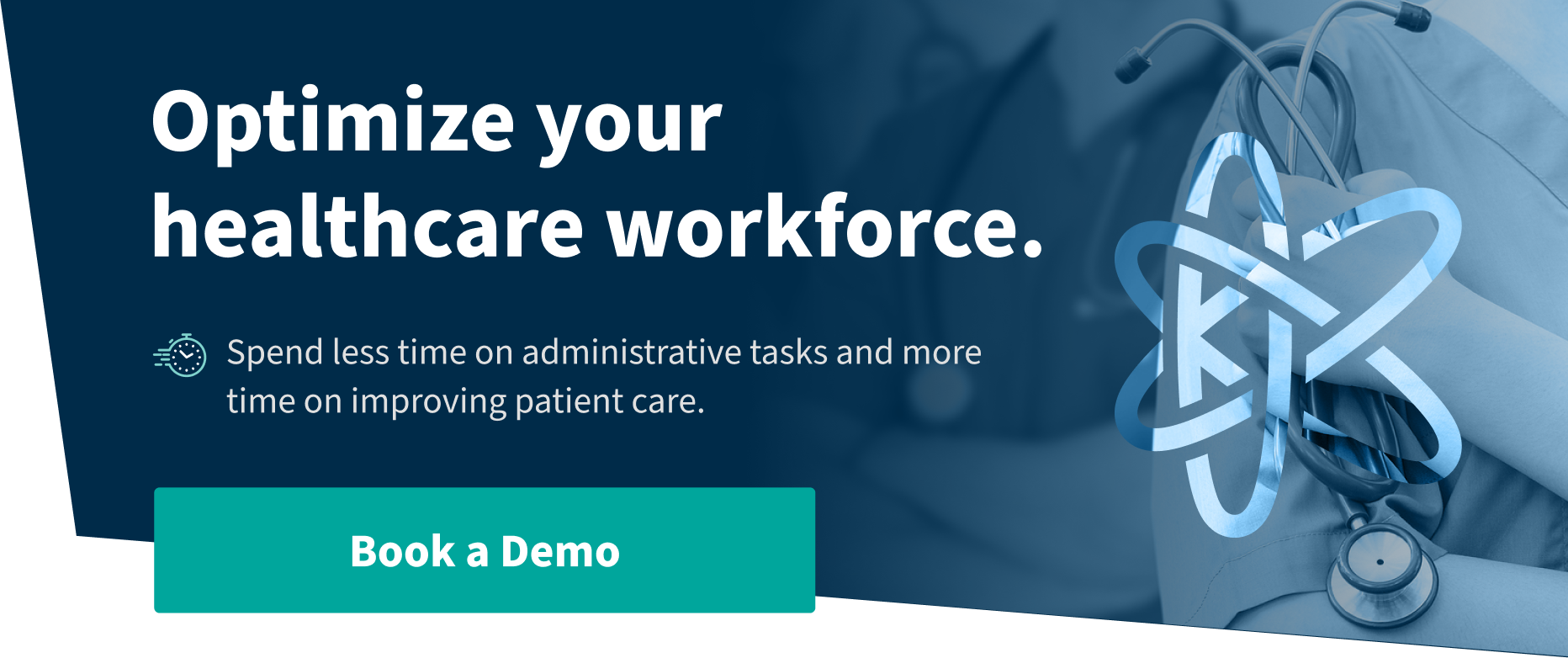How much time do you spend on a daily basis filling out paperwork for your healthcare organization’s scheduling needs? If you’re like most of our customers, your answer is probably “a lot more time” than you would like! Credentialing tasks and privileging packets can eat up a significant portion of your day, but there are other ways to manage these types of tasks. If instead, you had access to pre-filled forms, you could get all of that precious time back. And, that’s precisely what we want to share with you today - a way to save time with digital forms in Kimedics!
What are Digital Pre-filled Forms?
Like it sounds, digital pre-filled forms are forms that already contain standard, commonly used information that can be reused across multiple documents. Instead of requiring the provider or healthcare staff to enter repetitive credentials, experience and education, state license details, privileges and other data fields over and over again, digital pre-filled forms have many, if not all of these fields auto-populated based on information already stored in a profile or database.
This helps eliminate the redundancy and administrative hassle of repeatedly entering the same information on paperwork after paperwork through the provider onboarding, credentialing, enrollment and privileging processes. Once a physician's details are entered once and stored in a secure profile, this information can be effortlessly carried over from one form to the next using digital pre-fill technology.
Advanced digital pre-filled forms incorporate smart workflows and conditional logic beyond just storing basic profile information. For example, they may dynamically show specialty-specific modules only when relevant to that provider's scope of practice. Different forms may also call for sorting lists for dates newest to oldest, oldest to newest or just in the last 5 years, advanced
digital forms allow you to filter and sort information to bring the right data in, the way you need it presented. Reference letters, supporting documents, rates per hour, signatures, etc… may also be dynamically compiled based on specialty qualifications and facility requirements.
Overall, digital pre-filled forms powered by integrated databases, profiles and logic engines streamline data collection by reducing unnecessary repetitive information entry. This creates a much more automated, frictionless workflow allowing healthcare teams to spend less time managing paperwork and more time delivering quality patient care.
5 Tips to Save Time with Digital Pre-filled Forms
Digital forms can save you loads of time, and as a result money. That said, here are our top tips to save time with pre-filled forms:
- Leverage auto-populated fields for repetitive info
- Use conditional logic to show/hide irrelevant sections
- Let forms pull data from integrated databases, databases, filter and sort that data to bring it into the way the forms present it
- Enable batch uploading of info to multiple forms
- Implement eSignatures and the required fields for seamless workflows
Now that you know what these tips are, let’s break them down a little more so you can get back more hours in your day!
1. Leverage auto-populated fields for repetitive info
Instead of requiring hospital admins or providers themselves to track down and re-enter information such as medical licenses, DEA numbers, NPI numbers, contact info, or hospital affiliations, auto-populated fields extract the data from an integrated provider profile. From there it is filled into all associated forms with one click. No more playing data hunt, copy-paste, and reassembly across different documents for privileging packets and scheduling needs.
Auto-population eliminates rounds of back-and-forth verification of information between stakeholders by pulling verified details directly from the source. It also reduces human error from having to manually input a multitude of practice locations, license expiration dates, affiliations and other data points repeatedly.
Overall, auto-population of repetitive fields is a simple yet powerful way that digital pre-filled forms help users save significant time as well as frustration in the credentialing, privileging, enrollment and onboarding processes. Just set it and forget it in the profile, and let smart workflows do the repetitive paperwork for you!
2. Use conditional logic to show/hide irrelevant sections
Another way that digital pre-filled forms can save time is through conditional logic that displays only relevant sections or questions tailored to that specific provider.
For example, if a provider is an anesthesiologist, pre-filled digital forms will automatically show supplemental questions about procedures, modalities, or clinics related to their specialty. If they are a pediatric surgeon, it will display details applicable to children's hospitals and skills. If a psychiatrist, well, you get the idea.
This conditional branching eliminates the need to manually review long documents and determine which sections apply or don’t apply. And, scheduling staff won't have to waste time reading through and figuring out irrelevant clinical privileges or facility criteria.
Behind the scenes, integrations and rules engines pre-assess the provider type, specialty details, affiliations, and services to show or skip over sections accordingly per facility protocols. The forms self-configure for relevancy upfront.
Conditional logic removes redundant back and forth, confusion, and miscommunication around which parts do or don't apply. This saves lots of time across onboarding and credentialing workflows for everyone involved!
3. Let forms pull data from integrated databases
Rather than managing forms in a silo, advanced digital pre-fill platforms like Kimedics databases are most powerful when they connect to a healthcare specific database (Kimedics has both!).
This connectivity enables details housed in those downstream systems to seamlessly flow into provider pre-fill templates.
For example, specialty-specific facility criteria, service line details, affiliation specifics, and health network data can auto-populate directly from the source EHR or privileged management system. If details like insurance panel participation, health plan contracts, or credentialing expirations change in the database, digital forms stay dynamically up-to-date.
Tight bidirectional integrations eliminate manual tracking, transferring, and maintaining the same information in multiple disconnected places. This saves hospital IT teams and medical services professionals significant hours otherwise wasted copying and pasting data across siloed systems.
APIs also allow pre-fill platforms to receive updated provider information from association databases and state license directories. This means new enrollments, re-credentials, and modifications sync in real-time instead of requiring constant manual checking of multiple credentialing databases.
Overall, database integrations give pre-filled digital forms direct access to accurate source-of-truth data across the healthcare ecosystem. This keeps credentials current, avoids discrepancies, and prevents teams wasting time playing data catch-up across dispersed systems.
4. Enable batch uploading of info to multiple forms
Now that digital forms can securely integrate profiles, databases, and logic engines behind the scenes, teams should utilize batch uploading tools to efficiently pre-fill multiple documents at once. Things like licenses, insurance networks, specialty qualifications and even signatures propagate to all required paperwork simultaneously without re-entering any information manually.
Most digital pre-fill platforms come equipped with bulk upload capabilities or integration APIs allowing partner patient management systems to sync provider data across hundreds of network forms or applications at a time.
This batch upload functionality reduces hours of duplicate data entry down to minutes, if not seconds. It also minimizes frustrating inconsistencies due to information lagging or falling out of sync across dispersed documents.
5. Implement eSignatures for seamless workflows
Last but certainly not least, advanced digital pre-filled forms should incorporate eSignature functionality for paperless end-to-end workflows. This allows forms to be easily routed digitally from submitter to reviewer without printing, faxing or even e-mailing delay.
For example, once the medical services office completes the pre-fill process for a provider's privileging packet, they can instantly route to the department chair, committee members, and medical staff executives for official sign off and approval simply by clicking a button.
Notifications are automatically sent to the next reviewer as signatures are completed, with no email attachments to track or paperwork getting lost in transit through the facility. Everything remains visible and accountable within the digital pre-fill platform.
Integrated eSignatures keep packages moving through review steps seamlessly without logistics slow down or confusion over which physical copies are the latest versions. They save countless hours otherwise spent coordinating schedules, making copies, and driving forms around facilities begging for signatures.
How Kimedics’s Pre-filled Forms Streamline Provider Onboarding
Kimedics’s digital pre-filled forms and integrated privileging management tools provide significant time and efficiency gains for healthcare organizations managing the provider onboarding process.
Kimedics’s tools help reduce repetitive paperwork that collects redundant information across multiple onboarding, credentialing, and privileging documents. Core provider credentials, licenses, affiliations and other details only need to be entered once into the system. This information can then be automatically flowed into dozens of facility-specific forms with a few clicks.
The system's conditional logic functionality is also useful for simplifying relevant specialty-specific criteria which we discussed in our Privileging Waste reduction case study. Surgeons, for example, would only see facility protocols, service options, and qualifying criteria applicable to surgical specialties. Pediatricians would similarly skip irrelevant sections on trauma capabilities. This eliminated confusion and helped providers complete forms more quickly.
Changes to insurance panels, health plan contracts, and expiration dates auto-updated without manual tracking and data re-entry as well. Finally, Kimedics’s eSignature workflows routes completed credentialing and privileging packets digitally through department chairs, committee members, and executives for official sign off. This keeps review processes moving rapidly instead of getting stuck in email chains or print queues. And when the document is complete, it saves back to your checklist and clinician profile, to keep everything organized automatically
Learn how we can help your healthcare organization by booking a demo today!


